search for a Trip
Introduction of Lhasa
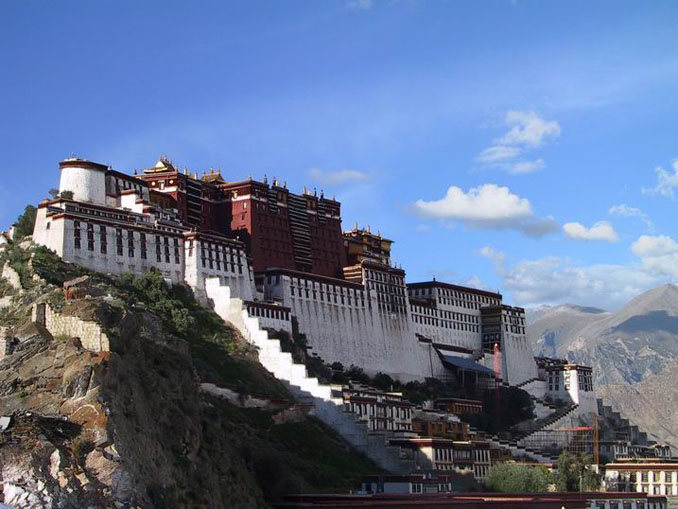
Lhasa (or the "ground of the Gods") has been the capital city of Tibet Autonomous Region since the 7th Century when Songsten Gampo built his palace where the Potala now stands and attempted to unify the various clans fighting in the area. This is the first stop for most visitors to Tibet and, although the journey here is not as exciting as it once was, a trip here is still an essential part of any visit to Tibet. Although Lhasa is famous for being one of the highest cities in the world, a towering 3,600 meters above the banks of the Lhasa River, what really knocks you out here is the full scale impact on your senses of the breathtaking beauty, unique landscape and the holy atmosphere of this religious center.
Main attractions in Lhasa and Tibet Autonomous Administration Region
Potala Palace
The Potala Palace, of course is a must. Its gold roofs are visible all over Lhasa, but most notably from the roof of the Jokhang. It's easy to see why the first Western visitors to Tibet were utterly enchanted with Lhasa.
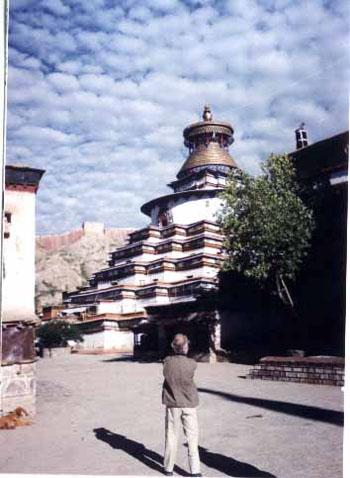
The sense of achievement at having finally attained this remote city, even by airplane, is still very real. Lhasa sits in a huge crater formed by mountains surrounding it on all sides. In the middle sits the Potala, itself atop its own sizeable hill. In front of it spreads the city and the Kyichu river. Behind it a veritable tapestry of fields and flowers spreads back to the mountains. A more picturesque scene could scarcely be imagined. The Potala is the official residence of the Dalai Lama, Buddhism's highest ranking priest. He is believed to be both a living god and an incarnation of all previous Dalai Lamas. Construction of the Potala Palace was begun by the 5th Dalai Lama, but it was not completed by the time of his death, in 1682. His regent concealed his death whilst the new Dalai was found [there is an elaborate process involved in locating the new Dalai upon the death of the previous incarnation]. The Potala contains treasures unimaginable, although it is unfortunate that very little of it is open to the public today. The Tomb of the Fifth Dalai Lama is within the Potala. It is three storeys high, and made of 3,700kg of gold. A multi-tiered model of a palace resembling a wedding cake, and made of over a quarter of a million pearls, is staggering to behold.
Jokhang Monastery
The Jokhang Temple, Lhasa's holiest temple, is situated bang in the middle of the city in the Barkhor Market district, and is easily visited alone. If you are lucky, a tour guide will be able to give information on the places visited, although don't expect too much. Usually little more than a bus from the hotel to the site is provided. Originally named "Ruosha", the Jokhang Temple was built in 547. According to legend,it was princess Wen Chen who chose the site for the temple through the methods of Ying-Yang and the Five Elements.
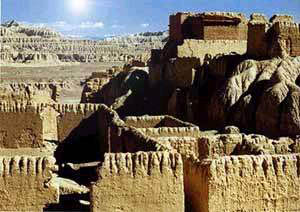
The Temple is situated near the Wuotang lake in the old urban area of Lhasa. This space is considered to be the heart of a monster who the Tibetan's want to drive away and the space was filled with water and a temple built on the site to drive out the monster from the area. After years of expansion, the Jokhang Temple is now part of a large group of buildings, covering a total area of 25,000 square meters. The four-storey main hall is magnificent with a Golden Summit. The statue of Sakyamuni that stands here is said to have been brought into Tibet by the Tang princess, Wen Chen. This statue is of paramount importance to Tibetan Buddhists and when the reincarnation of the Dalai and Pen Chen Lamas needs to be found, an official ceremony is held in front of the statue here.
Sera Monastery
Sera Monastery lies 4 km north of Lhasa, and was one of only eight (of some 3000) monasteries in all of Tibet to be spared the vicissitudes of the Cultural Revolution.
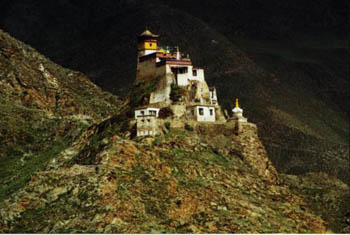
It is here that the monks' famous daily debates take place, at 3.30pm. They are highly stylized with much clapping and stamping, and always attract many spectators. Photos are no problem, which is very rare in Tibet, so make the best of it. Sky burials are still occasionally practiced at Sera, although they are much less common than they used to be because of the unholy and unhealthy interest shown by tourists. It is considered the height of indecency to intrude upon a sky burial. The deceased is chopped into pieces and left on the mountains for the vultures. Keep well away, curiosity notwithstanding.
Drepung Temple
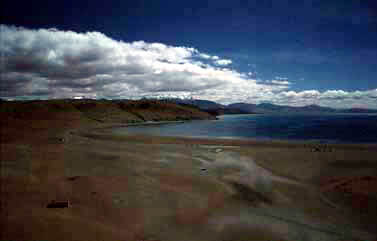
Drepung Monastery is actually a collection of Buddhist chapels and colleges located about 8km west of Lhasa. The word Drepung can be literally translated as "rice pile", a name whose meaning becomes clear when you see the white-walled buildings scattered along the hill. Originally founded in 1416, the monastery in its heyday was home to 10,000 monks (around 1600). In 1530, the second Dalai Lama built his palace here, known as the Ganden Palace, which was used until the fifth Dalai Lama built the Potala. Besides the Ganden Palace, the Drepung Monastery buildings also include the tsogchen(the main hall). This is the most important structure of the Monastery. It contains several chapels, of special note are the Chapel to the Maitreya Buddha and chapels to local Tibetan protection goddesses known as Tara. The Colleges of Drepang include the Ngagpa (focused on Tantric study), the Loseling (devoted to the study of logic and the largest of the colleges), and two other, lesser colleges. Monks are allowed to join a college based on their place of birth. This ages old "rule" gives each of the colleges an regional flair.
Norbulingka
 The Norbulingka is the Summer Palace of the Dalai Lamas and whiletruly run down, this garden still deserves a visit both for its historical and cultural significance. This area is especially interesting on festival days with lots to see. The park was established by the 7th Dalai Lama in 1755. More than just a simple summer retreat, this is the headquarters from which the Dalai Lamas ruled Tibet during the summer months. As successive Dalai Lamas all used the Summer Palace for this purpose, the procession from the Potala to Norbulingka became a grand affair and a festive occasion of the Lhasa calendar. In 1959, the current Dalai Lama (the 14th) made his escape from the Summer Palace disguised as a Tibetan soldier. Tibetan uprisings followed as the people of Lhasa swelled up to protect the Summer Palace and their spiritual leader, and the subsequent Chinese shelling of the area damaged all the buildings of the Norbulingka. Of special interest is the New Summer Palace, built by the 14th Dalai Lama and located in the center of the Norbulingka. This Palace is filled with interesting murals and is definitely the highlight of the Norbulingka.
The Norbulingka is the Summer Palace of the Dalai Lamas and whiletruly run down, this garden still deserves a visit both for its historical and cultural significance. This area is especially interesting on festival days with lots to see. The park was established by the 7th Dalai Lama in 1755. More than just a simple summer retreat, this is the headquarters from which the Dalai Lamas ruled Tibet during the summer months. As successive Dalai Lamas all used the Summer Palace for this purpose, the procession from the Potala to Norbulingka became a grand affair and a festive occasion of the Lhasa calendar. In 1959, the current Dalai Lama (the 14th) made his escape from the Summer Palace disguised as a Tibetan soldier. Tibetan uprisings followed as the people of Lhasa swelled up to protect the Summer Palace and their spiritual leader, and the subsequent Chinese shelling of the area damaged all the buildings of the Norbulingka. Of special interest is the New Summer Palace, built by the 14th Dalai Lama and located in the center of the Norbulingka. This Palace is filled with interesting murals and is definitely the highlight of the Norbulingka.
Ganden Monastery
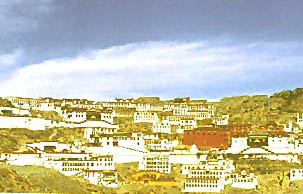 Ganden Monastery is located on Wangbur Mountain, on the southern bank of Lhasa River in Tagtse County, 47 kilometers (29 miles) from Lhasa City. It stands at an altitude of 3,800 meters (12,467 feet) above sea level! Ganden Monastery is one of the earliest and largest Buddhist monasteries in Tibet, and stands atop of the six famous temples of Gelugpa - a branch of Tibetan Buddhism. Its significance as a religious, artistic, political and cultural relic led to it being preserved by the National Key Cultural Relic Preservation scheme in 1961, and is now known as being one of the 'Three Great Temples', together with the Sera Monastery and the Drepung Monastery . Every year, one of the grandest of Buddhist activities - Buddha Painting Unfolding Festival - is conducted in the monastery, attracting thousands of visitors and disciples.
Ganden Monastery is located on Wangbur Mountain, on the southern bank of Lhasa River in Tagtse County, 47 kilometers (29 miles) from Lhasa City. It stands at an altitude of 3,800 meters (12,467 feet) above sea level! Ganden Monastery is one of the earliest and largest Buddhist monasteries in Tibet, and stands atop of the six famous temples of Gelugpa - a branch of Tibetan Buddhism. Its significance as a religious, artistic, political and cultural relic led to it being preserved by the National Key Cultural Relic Preservation scheme in 1961, and is now known as being one of the 'Three Great Temples', together with the Sera Monastery and the Drepung Monastery . Every year, one of the grandest of Buddhist activities - Buddha Painting Unfolding Festival - is conducted in the monastery, attracting thousands of visitors and disciples.
Lhasa Carpet Factory
Situated to the west of Tibet University Lhasa Carpet Factory is one of the remarkable enterprises in Tibet Autonomous Region, mainly producing traditional Tibetan Carpet. Hundreds of experienced weavers using old-styled vertical looms weave carpets. All the carpets here are hand-made in different sizes, styles, and patterns. Some are elegant, and some are colorful; they can be used as floor covering or hung on the wall as a beautiful picture. Every item is unique. The factory has developed into the biggest and the best in Tibet Autonomous Region with annual output of 30,000 miles of carpet. Tibetan Carpets, Persian Carpets and Oriental Artistic Carpets are reputed to be the best in the world. The designs of Tibetan carpets embody a flavor of the religions, culture, economy and people and the aesthetic of the patterns are always pleasing. Tibetan Carpets are always a hot seller both home and abroad. A Tibetan Carpet is an ideal purchase as a wonderful reminder of a trip to Tibet.
Yumbulagang Palace
Yumbulagang also called“palace of mother and son”in Tibetan dialect, is the first palace ever built in Tibet. It has a history of over 2,000 years. According to the history it was first built for Nyatri Tsanpo, the first Tibetan King. Later it became the summer palace of Songtsan Gampo and Princess Wencheng.
Namtso Lake :
Namtuo lake is the biggest lake throughout Tibet. Meanwhile, it is the highest altitude saltwater lake in the world. The water here is a storybook crystal-clear blue. Clear skies join the surface of the lake in the distance, creating an integrated, scenic vista. Soul of every visitor who has ever been here seems to be cleansed by the pure lake water. Besides the beautiful scenery in Namtso, it is also a famous sacred Buddhist place. There is a Zhaxi Temple in Zhaxi byland. In every Tibetan year of sheep, thousands of Buddhism adherents will come here to worship. As a rule, they will walk clockwise along the Namtso Lake in order to receive the blessing of the gods.
Everest
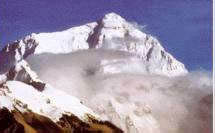 Mount Everest is situated at the edge of the Tibetan Plateau (Qing Zang Gaoyuan), on the border between Nepal and Tibet. The mountain was named for Sir George Everest, a British military engineer who served as surveyor general of India from 1829 to 1843, during which time the peak was surveyed. Everest was the first person to record the location and height of the mountain, then known as Peak XV. Most Nepali people refer to the mountain as Sagarmatha, meaning "Forehead in the Sky." Speakers of Tibetan languages, including the Sherpa people of northern Nepal, refer to the mountain as Chomolungma, Tibetan for "Goddess Mother of the World." In 1954, the height of Mount Everest was determined as 8848 m (29,028 ft)as the highest mountain in the world.
Mount Everest is situated at the edge of the Tibetan Plateau (Qing Zang Gaoyuan), on the border between Nepal and Tibet. The mountain was named for Sir George Everest, a British military engineer who served as surveyor general of India from 1829 to 1843, during which time the peak was surveyed. Everest was the first person to record the location and height of the mountain, then known as Peak XV. Most Nepali people refer to the mountain as Sagarmatha, meaning "Forehead in the Sky." Speakers of Tibetan languages, including the Sherpa people of northern Nepal, refer to the mountain as Chomolungma, Tibetan for "Goddess Mother of the World." In 1954, the height of Mount Everest was determined as 8848 m (29,028 ft)as the highest mountain in the world.
Mt Kailash:
Located in the far west of Tibet, Kailash is above 6638 sea level and is the main peak of the Gangdise Mountains. More than 250 glaciers around the peak make it the sources of the Indus, Ganges and Yarlung Zangbo Rivers. Mt. Kailash has the unique distinction of being the world's most venerated holy place at the same time that it is the least visited. The supremely sacred site of four religions and billions of people, Kailash is seen by no more than a few thousand pilgrims each year. This curious fact is explained by the mountain's remote location in far western Tibet. No planes, trains or buses journey anywhere near the region and even with rugged over-land vehicles the journey still requires weeks of difficult, often dangerous travel. The weather, always cold, can be unexpectedly treacherous and pilgrims must carry all the supplies they will need for the entire journey. Kangrinboqe Peak is the holy mountain in Tibet and attracts flocks of pilgrims from other parts of the country, India and Nepal to pay their respects to the Buddha. Also it is one of the pilgrimage centers of Tibet Buddhism, Hinduism and the Bon.
Lake Manasorowa :
One of the three sacred lakes in Tibet, Lake Mapam Yumco is a place respected by the Tibetan people, Lake Mapam Yumco is 4,587 meters above sea level. The lake covers an area of 412 square kilometers and is 77 meters deep. On the slope of the mountain by the lake stands the Jiniao Monastery, a best place to overlook the lake.
Guge Kingdom:
The Guge Kingdom is a wonder of Ngari. In the mid-nine century, the Tubo imperial court came to and end .The offspring of the King Namdam established their own kingdoms and Gyede Nyimagong became the king of Ngari. The second son of his three sons occupied Zarang and established the Guge Kingdom. In the main ruins of the Guge Kingdom in Zarang, the destroyed city walls and the natural earthen forests exist harmoniously. More than 400 houses and 800 caves scatter on the 300-meter-high mountain slope. As the capital of the Guge Kingdom, the Zarang Ruins cover an area of 720,000 square meters. It is the second largest building complex in Tibet next to the Potala Palace.
Climate of Lhasa
|
Month |
Jan |
Feb |
Mar |
Apr |
May |
Jun |
Jul |
Aug |
Sep |
Oct |
Nov |
Dec |
|
Temperature (Celsius) |
-4.6 |
-2.2 |
7.5 |
13.1 |
15.8 |
20.0 |
25.8 |
28.4 |
18.4 |
13.4 |
5.1 |
-1.7 |
China Attractions Guide
- Anhui Attractions
- Beijing Attractions
- Chongqing Attractions
- Fujian Attractions
- Gansu Attractions
- Guangdong Attractions
- Guangxi Attractions
- Guizhou Attractions
- Hainan Attractions
- Henan Attractions
- Hongkong Attractions
- Hubei Attractions
- Hunan Attractions
- Inner Mongolia Attractions
- Jiangsu Attractions
- Jiangxi Attractions
- Manchuria Attractions
- Ningxia Attractions
- Qinghai Attractions
- Shaanxi Attractions


